Hydrangea paniculata: secrets of care and reproduction
Paniculata hydrangea can often be found in the gardens of country houses and summer cottages. Its main feature is abundant flowering, unpretentiousness, frost resistance. Therefore, if you do not have time to spend all the time in the garden, but you want to make it unusual, then hydrangea will come in handy.
Content:
- Description of the plant
- Hydrangea paniculata care
- Reproduction and planting of hydrangeas
- Use in landscape design
Description of the plant
Hydrangea paniculata limelight is one of the most common varieties of hydrangea... It was named paniculata because of its inflorescence. The hydrangea inflorescences are large, sometimes reaching a length of 30 cm. The flowers of the plant are of two types: bisexual and sterile. The first ones are a little smaller, after pollination the petals fall on them. The second ones are larger, up to a maximum of 3 cm each, they remain on the bush for a long time.
From the beginning to the end of flowering, the flower changes its color, ranging from cream to pink and even red.
Hydrangea characteristic:
- Hydrangea Laimlat is a shrub plant, it is very neat, not sweeping, the maximum height and width is 2 meters.
- The plant grows and develops very quickly, 25 cm can be added per year (provided that it is properly cared for and the location is suitable).
- Hydrangea is famous not only for its flowers, but also for its unusual leaves. Their structure is velvety, soft. The leaves themselves are large, bright in color, sharp at the ends, located close to each other and completely cover the branch of the bush.
- The shape of the hydrangea limelight bush remains without any supports, while in some other varieties, large inflorescences bend branches with their weight.
- With the onset of autumn, the leaves change color to lilac, thanks to which the hydrangea limelat becomes even more beautiful and unusual.
- In autumn, sterile inflorescences are still kept, which during this period have a green color, then gradually turn yellow, and by the end of the season they become white.
- The flowering period lasts from July-August to October.
Landscape designers use the peculiarity of hydrangea flowering: when the garden has already bloomed, the hydrangea is only entering its most decorative period.
The name of the variety comes from the shade of the inflorescence - the color of lime, which they acquire at the beginning of the flowering period subject to suitable soil... If it is too sunny on the site, then the flowers will be white, which will acquire a pinkish tint by October.
The main requirements for growing: sunny area, moist fertile soil (loose and acidic is possible), lack of lime in the soil, tolerates winter well.
It was the Limelight variety that gardeners recognized as the most beautiful and resistant among other panicle hydrangeas.
Hydrangea paniculata care
Hydrangea paniculata loves a wet habitat:
- This does not mean that it needs to be transfused, although it is fine. settles on swampy soils.
- In order for the shrub to grow strong, and the inflorescences are lush and numerous, you need to water the hydrangea within a radius of 1.5 meters.
- If the weather is hot, be sure to water the shrub regularly.
- An important question is the choice of soil. For hydrangeas, loamy acidic soil is best suited.
- If the soil is alkaline, then the risk of leaf chlorosis and poor flower growth increases.
- If the soil is slightly acidic, then it is advisable to add ammonium sulfate or ferrous sulfate to it, the acidity will increase after the addition of peat and coniferous litter.
It is better to plant the hydrangea in partial shade, since the bright open sun negatively affects the growth of the plant and inflorescences.
Hydrangea does not like drafts and wind, so it is better to plant it near the walls of structures or hedges. Do not be afraid to grow hydrangea in the city, it tolerates gas pollution well. If the winter is harsh, then the hydrangea is sheltered from frost, if the winter is mild, then shelter is not required. If leaves or whole shoots damage the cold and they die off, they will quickly recover by summer.
A prerequisite for the development of hydrangeas is pruning in late winter or early spring.
It is important not to skip this period, since if you cut off the shoots late, this can harm the health of the shrub, as a result, it will be sensitive to the development of diseases and may not bloom. In general, pruning not only increases the immunity of hydrangeas, but also enhances the growth of shoots, the shrub becomes more lush.
As for feeding, then mineral fertilizers are applied every two weeks, organic fertilizers are applied once a month. This is done from early spring to late July. Already in August, feeding is stopped. To make the shoots stronger, once a month a solution of potassium permanganate is introduced into the ground (0.5 g of potassium permanganate per bucket of water).
Reproduction and planting of hydrangeas
Hydrangea reproduces in several ways:
- Cuttings.
- Division of the bush.
- Seeds.
- Vaccination.
Optimal time for rooting cuttings - mid-July, when the hydrangea is at its peak. Cuttings are cut from annual, lateral shoots, they are small and soft, not yet lignified. To choose a suitable shoot, you need to bend it, the correct one will not break. If the shoot is thick and fragile, it has already formed wood, then it will either take root badly, or it will not be suitable for reproduction at all.
You can carry out cuttings in June, then the cuttings must be taken with part of last year's shoot.
For rooting, a moisture-absorbing substrate is taken, which consists of two parts of peat and one part of coarse sand. Peat is necessary for a slightly acidic reaction, in which roots will begin to grow. The addition of sphagnum moss will increase soil moisture.
Features of cuttings6
- The cuttings are deepened into the mixture by 2-3 cm, they should be at a distance of about 4 cm from each other, the cuttings should be placed with a slight slope.
- The ambient air temperature should be within 20 degrees, if all the above conditions are met, rooting will occur in a month.
Reproduction by dividing the bush is a little easier:
- In early spring or autumn, the shrub is completely removed from the ground and divided into several parts, most often 2 or 3.
- It is important to make sure that there are several renewal buds left on each new shrub.
Seed propagation for many plants it is a rather difficult task, the same applies to hydrangeas, moreover, seed propagation is not suitable for varietal plants.
The seeds are laid out on the surface of the substrate with a slightly acidic reaction. The soil should consist of the following components:
- Coarse sand.
- Peat.
- Humus.
- Leafy land.
If sowing is done in the spring, then the seedlings can be seen in a month.
In order for development to go on the right path, young hydrangeas are fertilized with complex fertilizers. In the fall, seedlings can be transplanted into open ground; for the first winter, a good shelter is made.
Use in landscape design
Hydrangeas are transferred to a permanent place on the site only at 5 years old. To do this, you need a hole 40 cm deep and 60 cm wide.If a hedge is planned to be made from shrubs, then a meter strip is dug out for this.
At first, the distance between the shrubs is no more than a meter, while adult plants need 2.5 m.
Planting time varies from planting territory, in the north it is done in the spring, in the south in spring and autumn. To protect the hydrangea from overheating and weeds, the trunk circle must be mulched. Mulch is made from peat, bark and wood chips, all this mixture is laid out in a uniform layer of 10 cm around the shrub.
Using hydrangea:
- Hydrangea looks great in any garden; it is often used in projects by landscape designers. The type and variety of shrubs can be selected depending on the desired composition.
- Most often, the plant is used as a single plant and is planted simply on the lawn; group composite and hedges are also made from hydrangea. The large size of the shrub gives the garden a solemnity.
- Hydrangea is most often used to create the Russian style, it is planted in a pair with lilac, willow, birch, maple, etc. The most common combination of this shrub with any conifers. Looks great with a variety of flowering perennials, such as peonies, irises, roses.
Any gardener can control the shade of hydrangea inflorescences.
Cream or pink can be changed to blue or blue when conditions change. And it's not the variety itself, but the composition of the soil. If the soil is slightly alkaline, then the flowers will be pale or bright pink, if the soil is acidic, then the flowers will grow blue. White petals do not change their color.
This is due to the fact that the alkaline environment of the shrub does not receive the necessary iron. If it is necessary to grow blue hydrangeas, then a solution of iron salts is added to the soil, any iron objects or shavings can be put under the bush. To get a bright color, it will turn out only if the original was also bright.
There are such representatives when both blue and pink flowers grow on the same shrub.
Hydrangea is easy to care for and easy to propagate, it is resistant to parasites and disease. To grow a beautiful hydrangea in your garden, you need a little attention and knowledge of proper care.
More information can be found in the video.



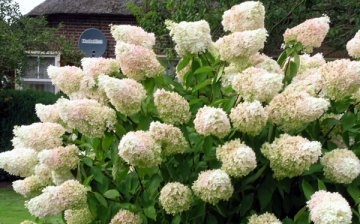
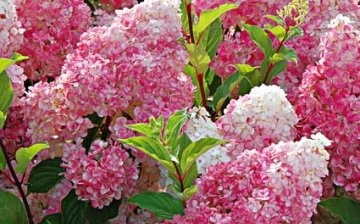
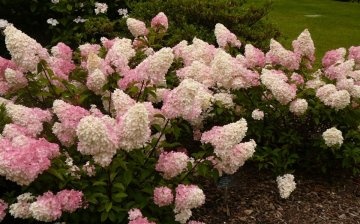
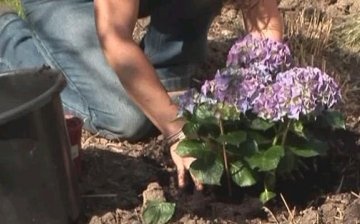






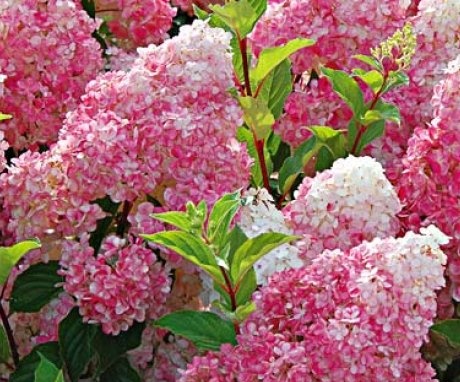
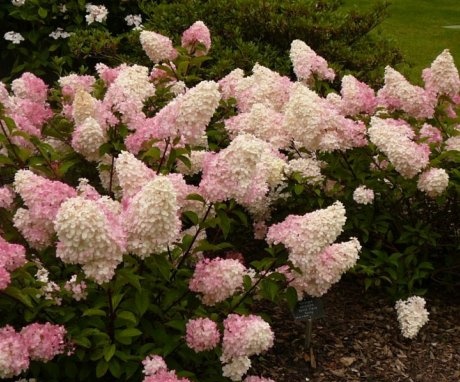

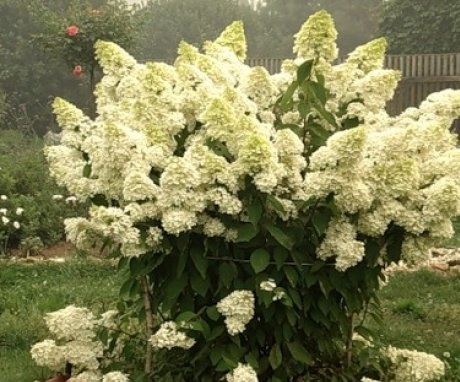
I read a lot and decided to buy myself a hydrangea for my dacha too. But after planting, her leaves began to turn black, what does this mean?